Wolverhampton Wanderers faced Sevilla in a highly anticipated quarter-final fixture of the Europa League. With both the English and Spanish sides having a similar standing in their respective leagues, they were expected to be evenly matched. Both teams have also enjoyed a dominant run this season with plenty of exciting football to challenge stronger teams.
The game held in Duisburg, Germany ended in favour of Sevilla who won 0-1 with Wolves heavily criticised for their negative tactics making the game boring for audiences despite being known for their tactical prowess. Sevilla, on the other hand, dominated possession and controlled the tempo from the start but failed to finalise any of the attacks in the final third and left it late to seal a ticket into the semi-finals.
In this tactical analysis, we shall examine how both sides played each other and take a closer analysis of their respective tactics.
Lineups
Wolves: Patricio, Doherty, Boly, Coady, Saiss, Vinagre, Neves, Dendoncker, Moutinho (Neto 71), Traore (Jota 79), Jimenez.
Unused subs: Ruddy, Sondergaard, Kilman, Richards, Buur, Marques, Jordao, Gibbs-White, Campana.
Head Coach: Nuno Esprito Santo
Sevilla: Bounou, Ocampos, Banega, Kounde, Navas, Carlos, Reguilon, Jordan (Vazquez 85), Fernando, En-Nesyri (de Jong 85), Suso (El-Haddadi 89).
Unused subs: Vaclik, Sanchez, Gomez, Munir, Escudero, Torres, Mena, Alonso, Genaro, Perez.
Head Coach: Julen Lopetegui

Wolves lined up in a 5-3-2 zonal-oriented defensive system with Adama Traoré and Raúl Jiménez as the two strikers. Rúben Neves played between João Moutinho and Leander Dendoncker but his usual freedom as a deep-lying playmaker was limited due to the rigid zonal setup.
Sevilla stuck to their standard 4-3-3 positional system with Youssef En-Nesyri as the target man and Lucas Ocampos and Suso playing alongside him. The two wingers inverting allowed the full-backs Navas and Reguilón to overlap and stretch the width. Joan Jordán played in the middle along with Fernando, with Fernando often dropping quite deep to split the centre-backs and build up play. Éver Banega had a free role as the playmaker but dominated the left half-space from a deep position.
Wolves defensive organisation
Nuno Espirito Santo’s defensive 5-3-2 came across as an unpleasant surprise to many who expected Wolves to take on the Spanish side with their own positional tactics that have proven to upset teams like Manchester City in the English Premier League. But considering how they managed to win an early penalty with Traore, it seemed like there was an intention to exploit the physicality of their players in a quick attacking transition.
The backline seemed like a flat back-five to defend against Sevilla stretching the play wide with their full-backs. The three centre-halves dealt with the threat of En-Nesyri and periodically Ocampos and Suso who had the freedom to drift inside or go wide or deep depending on the position of other players. The forwards chose not to press the centre-backs and only began to apply pressure zonally with the midfielders once the ball was played to the Sevilla midfielders. Thus the structure was a low-mid block.

In front of the line of five, the three midfielders, Moutinho, Neves, and Dendoncker defended zonally to prevent Sevilla from playing through their structure and forcing them to go over or around them. When the ball was on one side, two of the midfielders formed a box just behind the two strikers who also involved in the press. The wing-back was free to press the wide player if needed. Any penetrating pass in the half-space could be taken care of by the centre-backs.
In this scheme below we see how Moutinho, Neves, Jiménez, and Traore form a defensive zonal box applying pressure. Dendocker is free on the other side to initiate a counter-attack in case of a turnover. Traore being the highest player will attack the wide spaces between the Sevilla defenders.

During the first half, Wolves had only 23% of possession but created two big chances. They also had more dribbles (six successful out of seven) and had more number of tackles, interceptions, and clearances. The strategy seemed to have its rationale but with a goalless end to the first half, we did expect Santo to make some changes in the second half.
Sevilla attacking organisation
Sevilla played as the protagonist on the ball right from the beginning. They were very courageous to leave lots of spaces at the back and exercised plenty of rotations between the players. They averaged 681 passes with 88% pass accuracy. Although Wolves opted a defensive strategy to face them, Sevilla looked like they kept the Wolves on the back foot for most of the game with their proactive positional game.
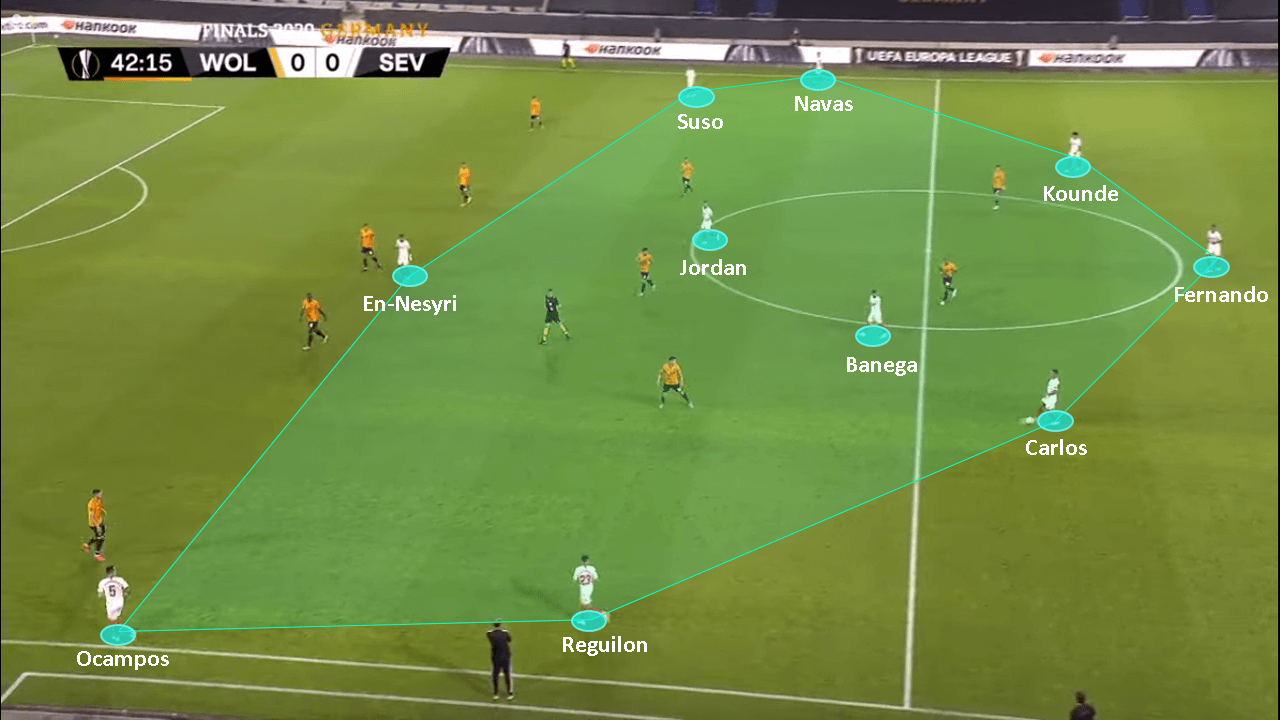
A significant tactic that Sevilla exploited in the build-up was to split the two strikers. Fernando played a big role in dropping deep between the strikers allowing the centre-backs, Jules Koundé and Diego Carlos, to move wider and find spaces in the inner corridor to build up. Banega often played deep himself on the left and began the first phase of build-up for Sevilla with the ball.
From the top, Ocampos and Jordán would drop into the spaces behind the two Wolves strikers to play a role in the consolidation phase once the first line of pressure was broken. They formed triangles and diamonds with the defenders and deep playmakers to recycle possession constantly and restart the build-up from deep areas. The fact that Wolves did not press the centre-backs too high made this task simpler and invited Sevilla to advance out of their defensive third.

This build-up structure permitted the wide players like Reguilón, Navas, or Suso to hold their wide positions and stretch the opposition structure by pinning back the Wolves wing-backs creating a 1 v 1 scenario on the flanks. From the top En-Nesyri would engage the centre-backs in a similar way.
Here we see a scheme where Fernando drops all the way to the defensive line forming a back three to build up. This allowed greater freedom for Koundé to carry the ball in search of a free passing lane if needed. Banega and Jordán controlled the half-spaces and since the Wolves midfielders sat zonally, the positional rotations of Sevilla always managed to create dynamic superiority in the middle for Sevilla to enjoy most of the ball.

Where they struggled was the finalisation phase, where the quality up top was not good enough to create many chances. Sevilla only managed five shots on target during the game despite having most of the ball possession.
Banega’s midfield masterclass
Much of Sevilla’s performance in Duisberg could be attributed to a very strong game by the Argentinian. He was the heart and soul of Sevilla’s structure and took the lead in every phase of the game. Banega had 102 accurate passes which was 17% of the total accurate passes that Sevilla made (614). A look at Banega’s heatmap shows how dominant he was in building up play from the left half-space despite having a free role to roam across the pitch.

When Sevilla conceded possession to Wolves, the strategy was to close the players down immediately with effective counter-pressing and force them to play back. If we look at the PPDA of both teams we see how Sevilla were able to maintain a consistently high pressing throughout the game which helped them control the tempo effectively.
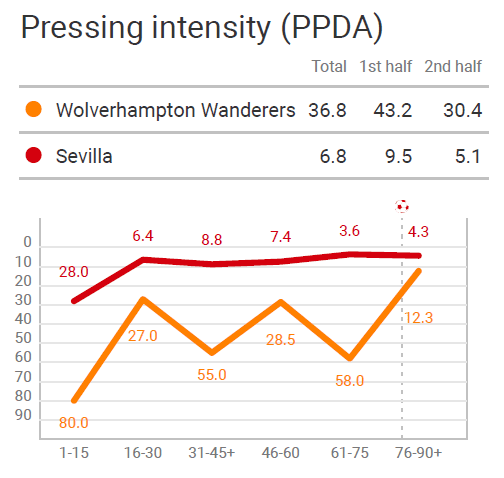
This counterpressing strategy was helpful since Wolves were shaped in a zonal defensive set up which meant they would not have more than one or two players in a good position to transition into attack. A look at the recoveries showed why Sevilla were much stronger in the second half because of the number of successful defensive actions in the opposition half, especially in front of the box.
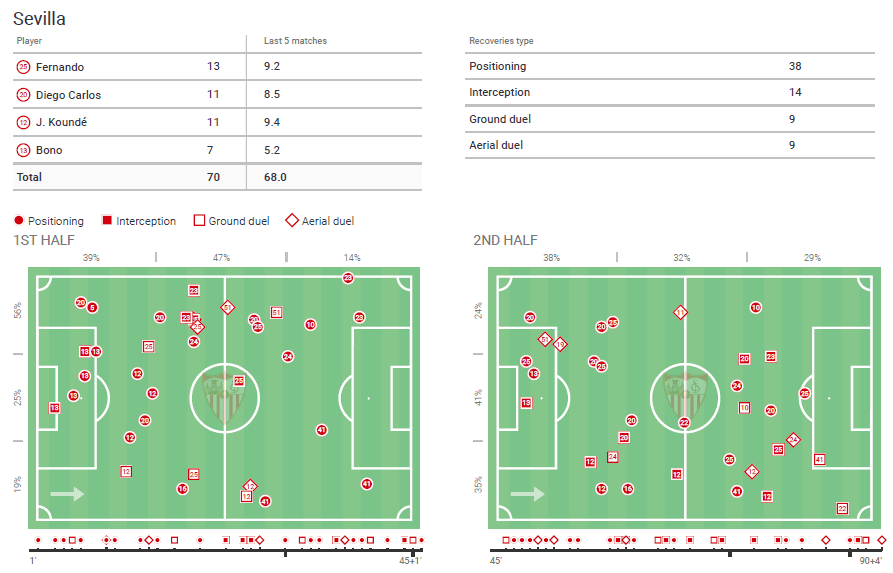
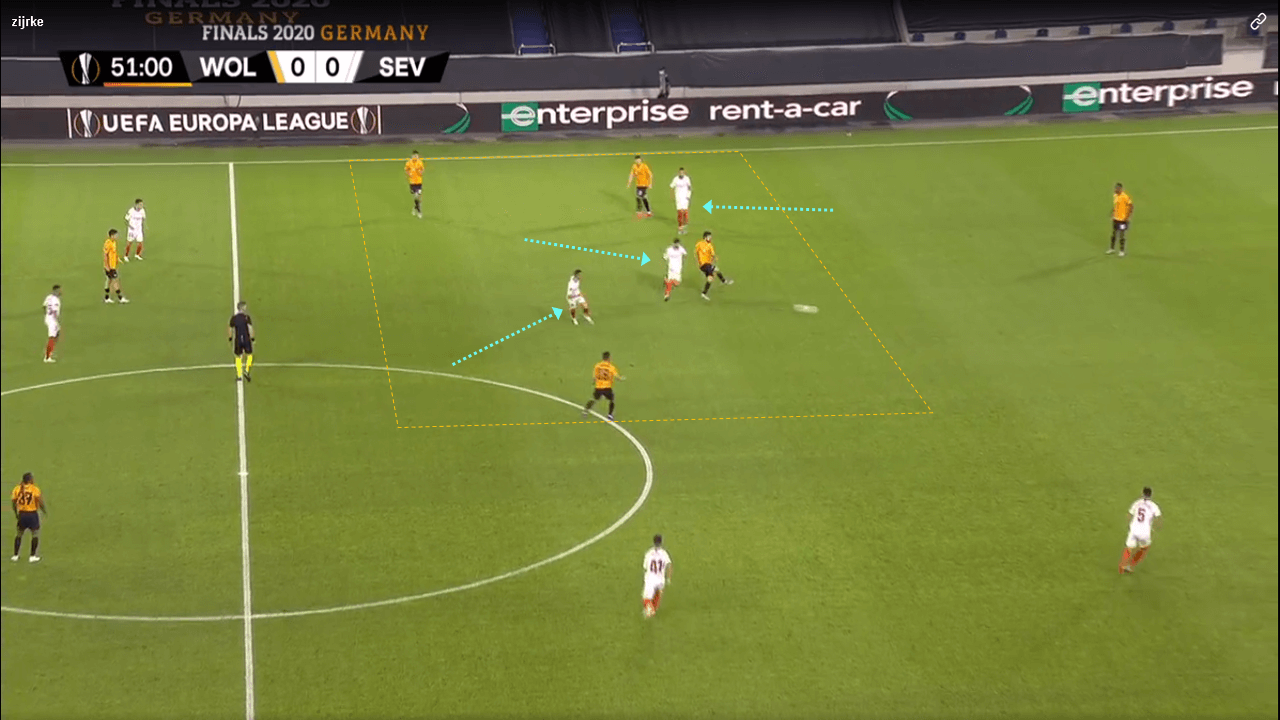
Above we see an example where Wolves have won the ball in midfield but are forced to play back because Sevilla have managed to apply immediate pressure in numbers creating a sudden overload. Since Banega had a rather free role to roam about the pitch and wasn’t positionally restricted, he could pick his moment to apply pressure and control Wolves’ movement without risk of leaving a lot of space to be exploited defensively. Many a time we saw Banega being the first to press from deep and apply a tackle at the right moment to stop a counter.
Below we see an instance where Banega receives a ball from the opposite flank, controls it, and then releases Reguilón with perfect timing behind the Wolves defence. He sees Ocampos dropping deep asking for a pass, bringing his marker along with him. This was the cue for Reguilón to begin attacking the space left behind, but the quality of the pass was inch-perfect and beautiful to watch.

In another instance, I highlight Banega’s game intelligence and control of Sevilla’s positional attack. Here Sevilla’s players are in a good position, occupying opposition markers and in the middle third of the pitch. A loose pass happens to be played back which Carlos sprints to collect facing away from play. When he wins the ball he would not have a free option to pass front and would be forced to play it back to the keeper forcing the entire shape to drop down and restart the build-up.
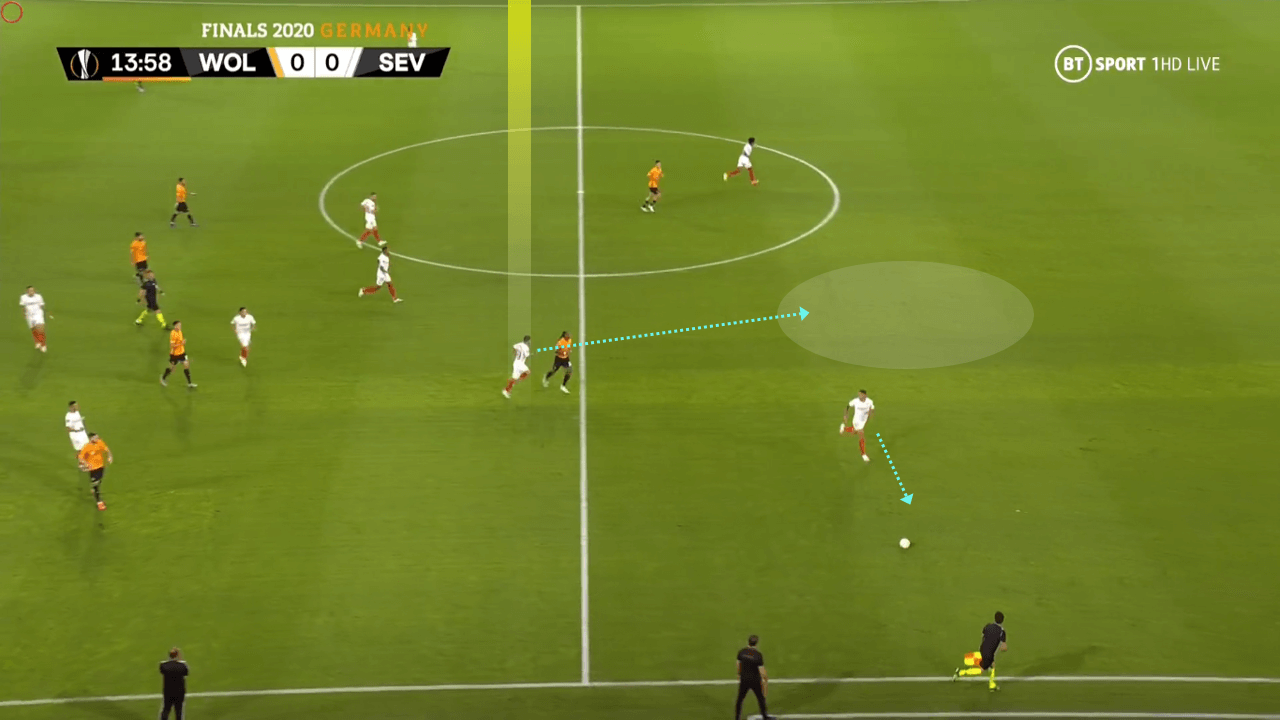
But Banega quickly reads this situation and sprints back behind Traore’s shoulder to Carlos’ position in the centre defence to receive the ball and recycle possession. This move enables Sevilla to hold their positions high and forces Wolves to sit back in their block.
Ocampos shines in the second half
Towards the end of the second half, the possibility of extra time seemed very likely with Sevilla unable to penetrate the robust defensive display by Wolves. When concentration levels were dropping and Sevilla were running out of ideas in the final third, Ocampos made sure the Sevilla engine was still sharp with some intelligent runs at the defence.
Ocampos kept threatening the backline with his perfectly timed runs and almost made En-Nesyri, who was usually outnumbered in the front, look invisible. Here we see how he recognises a little bit of space created by one of the three centre-backs disrupting the defensive line to press forward. Ocampos immediately makes an angled run to attack the space left behind and the timing of his run enables him to receive a pass in a good position for him to square it back into the penalty area.
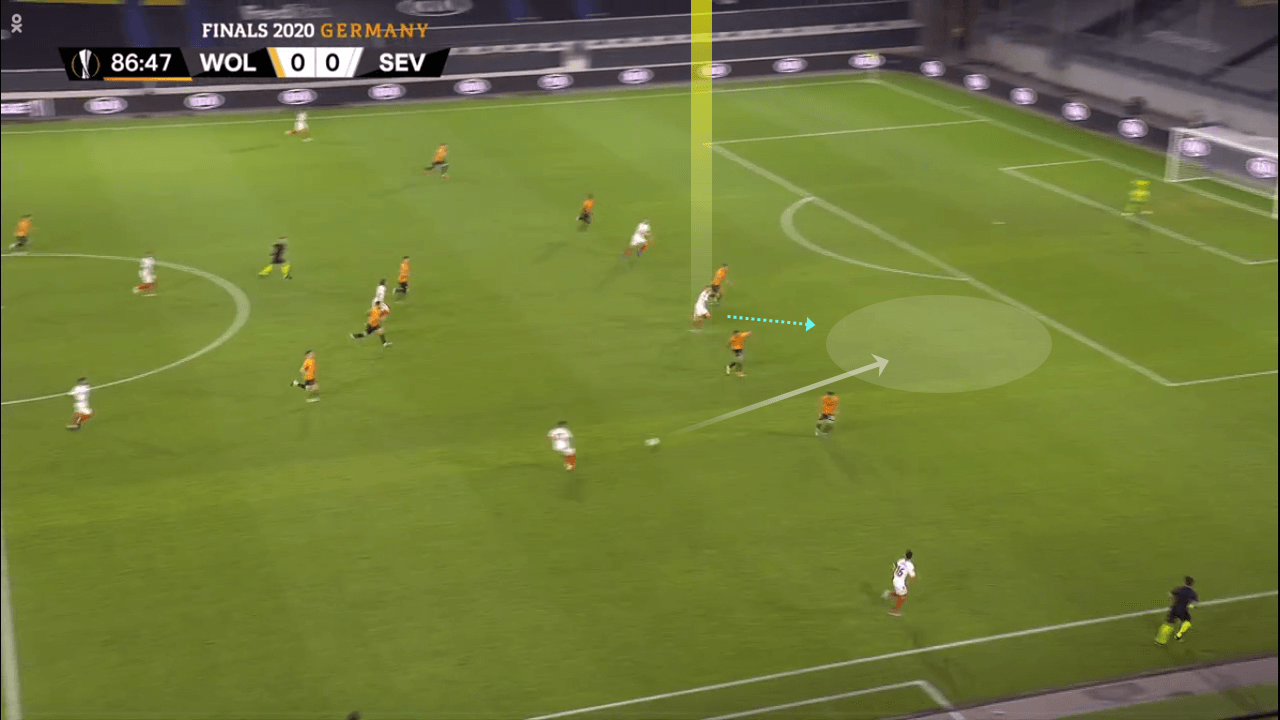
Let us take this instance where the ball is on the right flank. Ocampos first makes a movement towards the ball possessor. This movement triggers the centre-back who is marking him to push forward follow him.
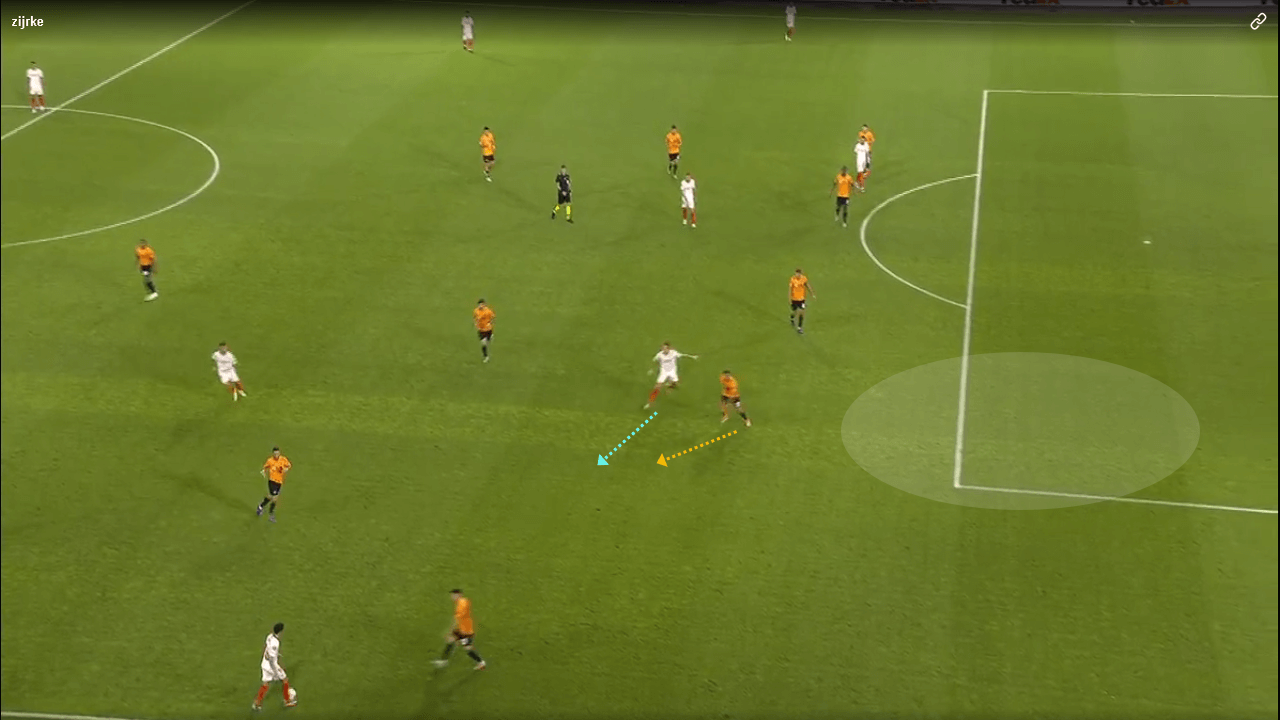
As the defender’s momentum is moving forward, Ocampos quickly changes direction and bursts behind with a sprint asking for the penetrating pass. The defender has no chance of turning backwards and catching up in time and he is thoroughly beaten with Ocampos’ move which is a typical centre forward tactic.
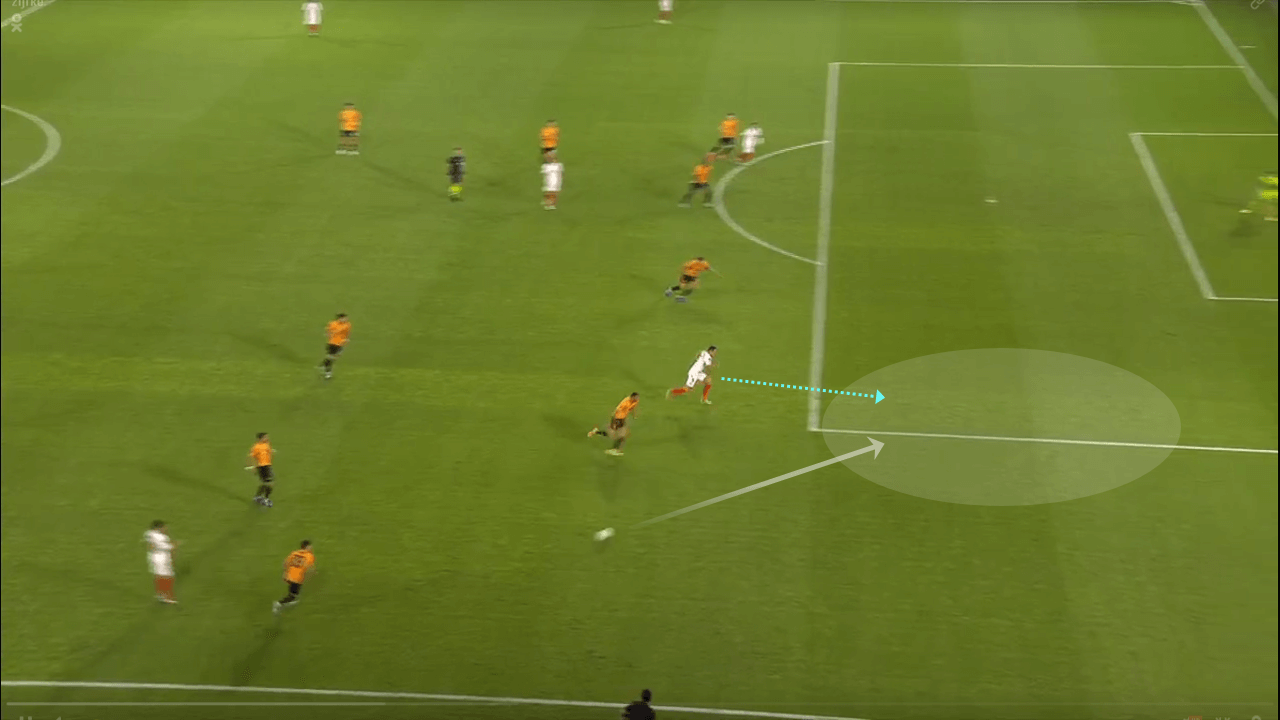
The decisive goal that he scored was also a product of intelligent movement. While the rest of the defenders were dropping back as Banega shaped up to cross the ball into the box, Ocampos took two steps forward creating confusion as to who was marking him. This split-second gave him enough space to attack the header into the far post and score the winner for Sevilla.
Conclusion
If we look at the xG timeline of the game, it explains why Wolves failed with their strategy. We see that their tactic looked strong until the penalty that Jimenez missed, but after that, they continued defensively without any change, while Sevilla only came out stronger as the game progressed.
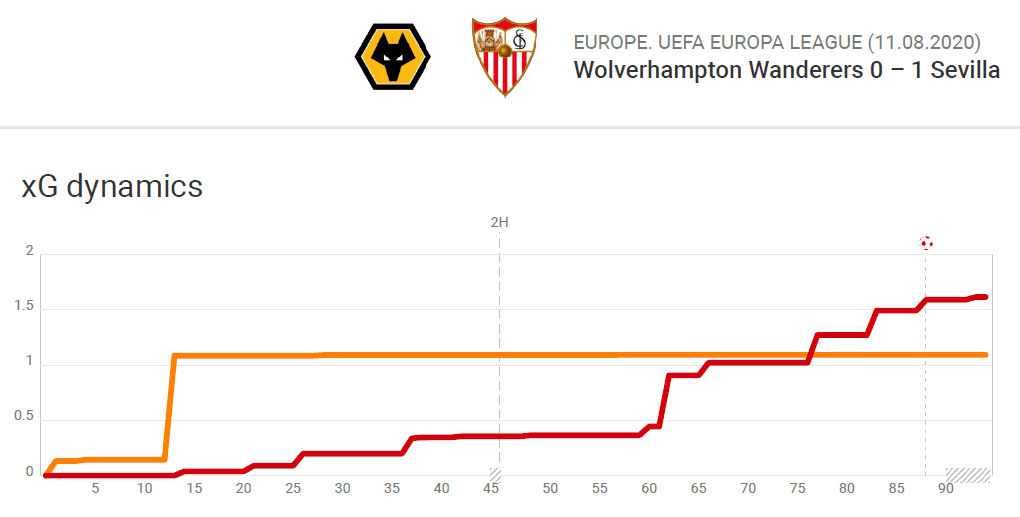
In the end, the goal from the second phase of the set-piece came too late for Wolves to manage any chance to recover. Wolves should have been braver and taken risks to come out and play earlier in the second half.
Sevilla’s performance although brave and dominant in the midfield highlighted once again their shortcoming in the attack. En-Nesyri and Luuk De Jong weren’t threatening enough to find a goal for Sevilla throughout the game. Ocampos had a strong game as a forward, and Banega’s midfield performance was textbook perfect but they carry too many responsibilities in the positional build-up of Sevilla to create enough scoring chances themselves. In the final stages of this tournament, the need for a clinical finisher or a player who can change the outcome of the game singlehandedly makes a big difference. At the moment, Ocampos is the sole contester for that role for Sevilla.





Comments